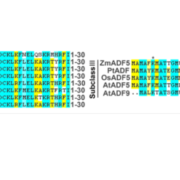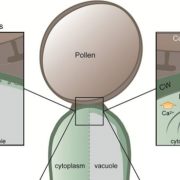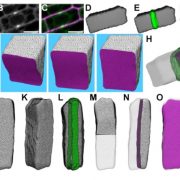Construction of a functional Casparian strip in non-endodermal lineages is orchestrated by two parallel signaling systems ($) (Curr. Biol.)
 The Casparian strip in the endodermis acts a barrier to allow the selective absorption of water and nutrients. Because of its cell-specific presence, the Casparian strip is considered a marker for functional endodermis. The cellular identity of endodermis is controlled by two transcription factors, SHR (SHORTROOT) and SCR (SCARECROW). In absence of SHR, the endodermal cell layer is lost. Additionally, peptides CIF1 (Casparian strip Integrity Factor) and CIF2 bind to the SGN3 (SCHENGEN 3) receptor and promote Casparian strip formation. In this paper, authors investigated the minimal requirement for creating a Casparian strip in a non-endodermal cell layer. Their results showed that SHR initiated an up-stream signaling cascade for Casparian strip formation and its three major targets are SGN3, SCR and MYB36. SGN1 and SGN3 regulate enzymes required for building the Casparian strip, SCR directs the subcellular localization of Casparian strip and MYB36 regulates the gene necessary for lignin polymerization. Altogether, this work suggests that combination of peptides CIFs and SHR-mediated network is sufficient to form functional Casparian strip in non-endodermal cells. (Summary by Arif Ashraf) Curr. Biol. 10.1016/j.cub.2018.07.028
The Casparian strip in the endodermis acts a barrier to allow the selective absorption of water and nutrients. Because of its cell-specific presence, the Casparian strip is considered a marker for functional endodermis. The cellular identity of endodermis is controlled by two transcription factors, SHR (SHORTROOT) and SCR (SCARECROW). In absence of SHR, the endodermal cell layer is lost. Additionally, peptides CIF1 (Casparian strip Integrity Factor) and CIF2 bind to the SGN3 (SCHENGEN 3) receptor and promote Casparian strip formation. In this paper, authors investigated the minimal requirement for creating a Casparian strip in a non-endodermal cell layer. Their results showed that SHR initiated an up-stream signaling cascade for Casparian strip formation and its three major targets are SGN3, SCR and MYB36. SGN1 and SGN3 regulate enzymes required for building the Casparian strip, SCR directs the subcellular localization of Casparian strip and MYB36 regulates the gene necessary for lignin polymerization. Altogether, this work suggests that combination of peptides CIFs and SHR-mediated network is sufficient to form functional Casparian strip in non-endodermal cells. (Summary by Arif Ashraf) Curr. Biol. 10.1016/j.cub.2018.07.028









